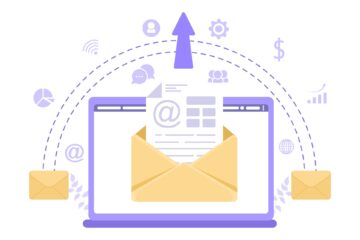In the dynamic world of field sales, how do you bridge the gap between your company and potential customers? The answer lies in a tool we often overlook: email.
But how does email communication reshape the landscape of field sales prospecting? Let’s embark on this journey together, armed with data, real-world examples, and actionable insights.
Understanding Email Communication and Its Mechanism
Email communication refers to the exchange of messages through electronic means, primarily over the Internet.
It functions by sending digital messages from one user to another, using specific protocols and systems. These messages can be retrieved and read at the recipient’s convenience, making it a flexible and efficient mode of communication.
Before the rise of email communication, prospecting was a more hands-on and direct process.
Salespeople would commonly depend on in-person meetings, visiting potential clients in person, or making unsolicited calls by phone. These approaches demanded substantial time, exertion, and frequently, travel. The goal was to establish a personal connection and pitch products or services directly to the potential customer.
The digital revolution brought about significant changes in the way sales prospecting was conducted. While conventional approaches such as knocking on doors and making cold calls remained valuable, the rise of email as a communication tool reshaped the scenario.
As businesses transitioned online, so did their target audience. Email allowed sales representatives to connect directly with these online customers, presenting an opportunity for more detailed product presentations and customized sales pitches.
Moreover, the ability to communicate with potential clients across different time zones without the constraints of typical calling hours was a game-changer. The advantages of email communication in sales prospecting are undeniable.
The immediacy of email, combined with its accessibility and the personal touch it can convey, has solidified its position in the sales toolkit.
As we look to the future, we can expect further innovations in email communication. With advancements in artificial intelligence and data analytics, emails might become even more personalized and tailored to individual client needs.
The integration of multimedia elements and interactive features could also enhance the user experience, making email an even more potent tool for sales prospecting.
Benefits of Email Communication in Field Sales Prospecting
In the ever-changing realm of sales, strong communication is essential. As businesses adjust to the digital era, the methods and approaches they use for finding potential clients also transform.
Among these methods, email communication shines as a revolutionary tool, providing numerous advantages that reshape the field of sales prospecting.
- Enhanced Reach and Accessibility: Email communication has revolutionized the way sales representatives connect with potential clients. It offers an unparalleled reach, allowing sales teams to tap into a global audience with just a few clicks. No longer are sales teams confined to their local markets; they can now prospect globally, expanding their potential client base exponentially.
- Overcoming Geographical Barriers: The digital nature of email means that geographical boundaries no longer pose a challenge. A sales representative situated in New York can seamlessly engage and finalize deals with a client in Tokyo. This global reach ensures that businesses can cater to diverse markets, understanding and meeting the unique needs of clients from different cultural and economic backgrounds.
- 24/7 Communication: Unlike traditional communication methods that are bound by time zones and working hours, email operates round the clock. This ensures that messages are delivered instantly and can be accessed by prospects at a time that suits them best. Such flexibility enhances the user experience, ensuring that communication is not just timely but also convenient.
- Personalization and Tailored Messaging: Personalized emails resonate more with recipients. By crafting messages that address the unique needs, preferences, and pain points of each prospect, sales reps can foster a deeper connection. This not only increases the likelihood of engagement but also positions the sales rep as a solution provider, enhancing trust and credibility.
- Addressing Specific Needs: Tailored email campaigns have the power to make recipients feel valued and understood. By focusing on the specific needs of each prospect, sales teams can offer solutions that are both relevant and timely. For instance, a well-crafted email that highlights how a product can address a particular challenge faced by a prospect can significantly increase conversion rates.
- Cost-Effectiveness and Efficiency: Email communication offers a more economical alternative to traditional sales prospecting methods. No requirement for face-to-face meetings, faraway calls, or printed materials. The cost savings are significant, and when combined with the impressive return on investment from email campaigns, it’s evident why email is the top pick for numerous sales teams.
- Role of Automation: Automation has transformed the way sales teams approach email campaigns. Tools like HubSpot and Mailchimp offer features that automate various stages of the email campaign process, from sending out messages to tracking engagement metrics. This not only saves time but also ensures that no opportunity is missed, enhancing the overall efficiency of the sales process.
- Integrated Analytics and Tracking: Modern email platforms come equipped with robust analytics tools. These tools provide insights into how recipients engage with emails, offering data on open rates, click-through rates, and conversion metrics. Such insights are invaluable for sales reps, allowing them to refine their strategies, optimize their messaging, and ultimately, achieve better results.
Email communication offers a range of benefits for sales prospecting. As we navigate the digital age, email is becoming even more vital for effective communication.
Embracing its power can foster better connections, higher conversions, and overall company expansion.
Crafting Effective Sales Emails
In the complex world of sales, communication sets the beat for success. Among a salesperson’s many tools, emails stand out as powerful, effortlessly spanning distances and time zones.
Yet, an email’s success isn’t just about its content; it’s about how it’s created. Let’s explore the art of making impactful emails, ensuring each message not only reaches its audience but truly connects.
1. Building a High-Quality Prospect List
A high-quality prospect list is a curated collection of potential clients or customers who are most likely to be interested in a company’s product or service.
This list is characterized by its precision, ensuring that the individuals or entities included align closely with the company’s ideal customer profile.
Building such a list involves a meticulous process of identifying and understanding the target audience. It’s not only about collecting names and contact information; it’s about making sure these prospects meet the criteria of potential customers who would truly gain from the product or service provided.
For instance, when promoting a premium software solution, it’s smarter to target pivotal decision-makers like CTOs and IT managers instead of junior staff.
By categorizing potential clients based on specific criteria, such as industry or job role, sales reps can craft messages that resonate more deeply, ensuring relevance and impact.
Both organic and paid lead generation methods have their merits in building a prospect list. Organic methods, like content marketing or referrals, build trust and often yield highly engaged prospects. On the other hand, paid methods, such as targeted ads or purchasing lists, can provide a quick influx of leads, though the quality might vary.
Best Practices for Building a High-Quality Prospect List
- Research Thoroughly: Understand the market, industry trends, and the challenges faced by potential clients.
- Utilize Technology: Employ CRM tools and lead generation software to streamline the process.
- Engage in Networking: Attend industry events, webinars, and seminars to meet potential leads.
- Prioritize Referrals: Leverage existing clients or partners for referrals, as they often lead to high-quality prospects.
- Maintain Data Hygiene: Regularly update and clean the list to remove outdated information or uninterested parties.
- Offer Value First: Provide valuable content or insights to attract genuinely interested prospects.
- Monitor and Iterate: Continuously assess the effectiveness of your strategies and make necessary adjustments.
In field sales prospecting, time and resources are of the essence. A high-quality prospect list ensures that sales reps focus their efforts on potential clients who are most likely to convert, maximizing efficiency and ROI.
By targeting the right audience with tailored messages, sales reps can foster meaningful connections, drive conversions, and ultimately, achieve sustainable business growth.
2. Creating Compelling Email Content
Captivating email content goes beyond skillful writing; it blends relevance, involvement, and clarity to seize the reader’s focus and inspire action.
This content connects with the recipient, making sure that the message is not only read but also remembered.
- Engaging Subject Lines: The first point of contact that determines if an email gets opened.
- Relevant Body Content: Information that directly addresses the recipient’s needs or interests.
- Visual Elements: Graphics or images that complement and enhance the written content.
- Clear Call-to-Actions (CTAs): Direct prompts that guide the reader on the next steps.
- Personalization: Tailored content that speaks directly to the individual recipient.
Crafting compelling email content is an art that balances the needs of the recipient with the objectives of the sender. It starts with an engaging subject line that sparks curiosity, drawing the reader into the body of the email.
Within the email, clarity and engagement must coexist, ensuring that the message is both understandable and captivating. Moreover, the content should be tailored, making the recipient feel that the email was crafted specifically for them, enhancing its impact.
Best Practices for Creating Compelling Email Content
- Research Your Audience: Understand their needs, preferences, and pain points to tailor your content.
- Use A/B Testing: Test different versions of your email to determine which resonates more with your audience.
- Incorporate Storytelling: Share success stories or customer testimonials to build trust and credibility.
- Optimize for Mobile: Ensure that your emails are readable and look good on mobile devices.
- Limit Distractions: Keep the content focused on one primary message or offer.
- Include Social Proof: Showcase reviews, ratings, or endorsements to enhance credibility.
- Stay Updated with Trends: Keep abreast of email marketing trends to ensure your content remains fresh and relevant.
In the realm of field sales prospecting, where the competition is fierce and attention spans are short, compelling email content is a game-changer. It ensures that the sales rep’s message breaks through the noise, capturing the attention of potential clients.
More than just getting the email opened, compelling content drives engagement, fosters trust, and paves the way for meaningful interactions that can lead to successful conversions.
3. Strategizing Follow-Ups
An email follow-up is a subsequent communication sent after an initial email, aiming to re-engage the recipient, address any queries, or further the conversation.
It serves as a reminder, a nudge, or an additional value proposition, ensuring that the initial message’s intent is reinforced or clarified.
Key Factors to Consider When Conducting Email Follow-Ups
- Recipient’s Response: Whether the initial email received any engagement or feedback.
- Timing: The interval between the initial email and the follow-up.
- Content Relevance: Ensuring the follow-up provides additional value or addresses potential queries.
- Tone and Approach: Maintaining a respectful and non-intrusive demeanor.
- Feedback Mechanisms: Providing avenues for the recipient to respond or engage further.
Planning follow-ups is the skill of deciding when and how to reconnect with a prospect after the first contact. It’s more than just sending another email; it involves grasping the recipient’s actions, assessing their interest, and sharing content that connects.
The timing of the follow-up matters, as it can shape how the sales rep and the company are seen. Moreover, the content of the follow-up should be tailored based on previous interactions, ensuring it addresses the prospect’s needs or concerns.
Best Practices for Strategizing Follow-Ups
- Leverage Analytics: Use tools like Yesware to gain insights into optimal follow-up times based on recipient engagement.
- Avoid Being Overly Persistent: Space out follow-ups to avoid overwhelming or annoying the recipient.
- Personalize Content: Reference previous interactions or feedback to make the follow-up more relevant.
- Set Clear Objectives: Determine what you aim to achieve with the follow-up, be it seeking feedback, providing additional information, or nudging for a decision.
- Provide Value: Offer something new or insightful in the follow-up, such as a case study, a discount, or an exclusive piece of content.
- Seek Feedback: Encourage recipients to share their thoughts or concerns, fostering two-way communication.
- Stay Updated: Keep abreast of any changes or updates related to the prospect or their company that might influence the follow-up content.
In field sales prospecting, the journey often extends beyond the initial outreach. Strategized follow-ups ensure that potential leads remain engaged and that opportunities are not lost due to lapses in communication.
By understanding and addressing the needs of prospects through well-timed and relevant follow-ups, sales reps can build stronger relationships, enhance trust, and significantly increase the chances of successful conversions.

4. Optimizing Email Design for Various Devices
Email design refers to the visual and structural layout of an email, encompassing elements like typography, images, and overall aesthetics.
Key Aspects of a Well-Optimized Email Design
- Readability: Ensuring the content is legible across various devices and screen sizes.
- Visual Appeal: Incorporating graphics, colors, and typography that align with the company and engage the reader.
- User Experience: Designing for easy navigation, clear call-to-actions, and minimal load times.
- Consistency: Maintaining uniform branding and messaging across all email communications.
- Adaptability: Ensuring the design adjusts seamlessly across different devices and platforms.
In the modern digital landscape, individuals access their emails on a multitude of devices, each with its unique screen size and resolution.
As such, optimizing email design for various devices means ensuring that emails are not only visually appealing but also functional across all these platforms. A responsive design ensures that the email’s layout, images, and typography adjust to provide the best viewing experience, regardless of the device used.
Moreover, beyond mere responsiveness, it’s vital to maintain visual consistency, ensuring that the company’s identity and message remain coherent and impactful.
Best Practices for Optimizing Email Design for Various Devices
- Prioritize Mobile Design: Given the increasing use of mobile devices, design emails with mobile-first in mind.
- Test Across Platforms: Use tools like Litmus to check how emails render on different devices and email clients.
- Use Scalable Graphics: Implement vector images or SVGs that scale without losing quality.
- Avoid Large Attachments: Ensure faster load times by minimizing the size of embedded images or files.
- Implement Fluid Layouts: Use flexible grids and layouts that adjust based on the screen size.
- Opt for Stacked Content: On smaller screens, stack content vertically for better readability.
- Maintain Touch-Friendly CTAs: Ensure that buttons and links are easily clickable on touch devices.
For field sales prospecting, first impressions are pivotal, and emails often serve as that initial touchpoint. By optimizing email design for various devices, sales reps ensure that their outreach is professional, coherent, and engaging, regardless of how a prospect accesses it.
This adaptability not only enhances the user experience but also maximizes the chances of engagement and conversion, driving success in sales initiatives.
5. Incorporating Feedback and Analytics
Feedback and analytics refer to the collection and analysis of data regarding user interactions and responses to specific initiatives, such as email campaigns.
While feedback captures the qualitative insights and opinions of the audience, analytics provides quantitative data on user behavior and engagement metrics.
- Data Accuracy: Ensuring that the collected data is reliable and free from discrepancies.
- Relevance of Metrics: Focusing on metrics that align with the campaign’s objectives and goals.
- Feedback Channels: Identifying the avenues through which feedback is collected, such as surveys or direct responses.
- Data Interpretation: Understanding the implications of the data and drawing actionable insights.
- Integration with Other Tools: Ensuring that the analytics platform can integrate with other marketing and sales tools for a holistic view.
Incorporating feedback and analytics means actively using the qualitative and quantitative data gathered from email campaigns to inform and refine future strategies.
It’s about understanding the audience’s behavior, preferences, and pain points through measurable metrics and direct feedback. This iterative process allows sales reps to make informed decisions, optimizing their approach for better engagement and results.
Best Practices for Incorporating Feedback and Analytics
- Set Clear Objectives: Before collecting data, define what you aim to achieve or understand from the analytics and feedback.
- Utilize Comprehensive Platforms: Use tools like Mailchimp and HubSpot that provide a wide range of analytics and integration capabilities.
- Segment Data: Categorize data based on specific criteria, such as demographics or user behavior, for more targeted insights.
- Act on Feedback Promptly: Address any concerns or suggestions from the audience in a timely manner to show that their feedback is valued.
- Regularly Review Metrics: Continuously monitor key metrics to identify trends, spikes, or anomalies.
- A/B Testing: Test different versions of emails to determine which elements resonate most with the audience.
- Educate the Team: Ensure that all sales team members understand the significance of the data and how to interpret it for better decision-making.
In the realm of field sales prospecting, understanding the audience is paramount. Feedback and analytics offer a window into the minds and behaviors of potential clients, providing invaluable insights that can shape outreach strategies.
By incorporating this data, sales reps can tailor their approach, ensuring that their messages resonate more deeply with prospects.
Furthermore, this data-driven approach not only enhances engagement but also ensures that resources are allocated efficiently, maximizing the return on investment.
Metrics, Analysis, and Continuous Improvement
In the intricate landscape of sales, data serves as the compass guiding strategies and decisions. But how can sales professionals transform raw numbers into actionable insights?
Interpreting Email Metrics
Metrics such as open rates, click-through rates, and response rates offer invaluable insights into the effectiveness of an email campaign.
These figures not only indicate the level of engagement with your emails but also highlight their efficacy in guiding prospects along the sales journey.
For context, if we consider industry benchmarks, a B2B email campaign that achieves open rates between 15-25% is generally deemed successful. Achieving or surpassing these benchmarks indicates that the campaign is resonating well with its audience.
Beyond engagement metrics, the ultimate measure of an email campaign’s success is its conversion rate.
By diligently tracking conversions, sales representatives can ascertain the tangible outcomes of their email initiatives. Utilizing platforms like Google Analytics can offer a deep dive into conversion metrics, illuminating the strengths and areas of improvement in a campaign.
Leveraging Data for Enhanced Strategies
- Understanding Patterns: Examining how recipients engage with emails offers insights for refining outreach strategies. For instance, if specific subject lines consistently lead to high open rates, it suggests using similar themes in upcoming campaigns.
- Effective A/B Testing: When making decisions for email campaigns, like choosing designs or subject lines, A/B testing acts as a comparison test. It helps gauge which option performs better by testing two variations. Tools like Optimizely specialize in conducting A/B tests, ensuring campaigns are optimized using real-world data.
- Personalization through Segmentation: By analyzing recipient behavior, sales reps can categorize their email list more precisely. This enables personalized content that resonates with specific audience segments. For instance, if data reveals a segment’s interest in a particular product feature, future emails can highlight that feature for them.
- Incorporating Feedback: Actively seeking and analyzing feedback from recipients provides direct insights into email effectiveness. Whether it’s about content, design, or overall messaging, integrating these insights ensures future campaigns better match audience preferences.
- Analyzing Trends: Monitoring emerging trends in email engagement helps sales reps stay proactive. Recognizing shifts in metrics like click-through or conversion rates allows for timely strategy adjustments. For instance, if video content sees increased engagement, it might be wise to invest more in such content for upcoming campaigns.
Metrics and analysis are the bedrock of informed decision-making in field sales prospecting. By continuously monitoring, analyzing, and iterating based on data, sales professionals can ensure that their outreach is both effective and efficient.
This data-driven approach not only maximizes engagement and conversions but also fosters a culture of continuous improvement, setting the stage for sustained success in sales endeavors.
Integrating Email with Other Sales Techniques
While email remains a cornerstone in sales outreach, it’s essential to recognize its role within a broader spectrum of sales techniques. So, how can email be synergized with other methods to amplify its effectiveness?
1. Collaboration with Cold Calling
A strategically composed email can serve as a primer, making the recipient more amenable to an ensuing phone call. Ever observed how a phone call post a significant email exchange feels less like a sales pitch and more like a continuation of a dialogue?
Synchronizing email and telephonic outreach strategies ensures a fluid experience for potential clients, enhancing the likelihood of a successful conversion.
For instance, a call following an in-depth product email can address any lingering queries, adding a personal dimension to the interaction.
2. Augmenting Social Selling
In our interconnected era, interactions on platforms like LinkedIn or Twitter can be as influential as traditional emails. By orchestrating efforts across these social networking channels, sales representatives can weave a consistent company brand story.
For example, disseminating an email campaign’s content on LinkedIn can extend its influence, engaging a more expansive set of potential clients.
Social platforms facilitate casual, genuine interactions, enabling sales professionals to foster authentic bonds with potential clients. Engaging in substantive dialogues on platforms like LinkedIn or Twitter can set the stage for more structured email communications.
3. Integration with Webinars and Virtual Events
Before hosting a webinar or virtual event, emails can be used to generate interest, provide details, and encourage registrations.
After the event, emails serve as an excellent tool to share key takeaways, additional resources, and gauge feedback, ensuring continuous engagement.
4. Synchronization with Content Marketing
Emails can be used to promote new blog posts, whitepapers, or case studies, driving traffic and fostering engagement.
Gathering feedback on the content through emails can provide insights for future content creation and refinement.
5. Harmonizing with Referral Programs
Encourage satisfied clients to refer others through personalized email invitations, offering incentives or rewards.
Once a referral is made, use emails to thank the referrer and keep them informed about the referral’s progress.
6. Alignment with Customer Surveys
Use emails to distribute customer satisfaction surveys, gathering insights on product usage, and overall experience.
Based on survey results, tailor follow-up emails to address specific concerns or highlight new features that cater to the feedback received.
7. Cooperation with Loyalty Programs
Introduce existing customers to loyalty programs through emails, highlighting the benefits and rewards.
Keep members updated on their loyalty points, rewards, and exclusive offers through periodic emails.

Final Thoughts | Embracing Email Communication in Field Sales
As we’ve seen, email communication plays a pivotal role in field sales prospecting. From building connections to closing deals, it’s a tool that every sales rep should master.
By understanding the nuances and intricacies of email prospecting, sales teams can elevate their outreach, build meaningful connections, and drive conversions.
So, as you embark on your next email campaign, remember: it’s not just about sending a message; it’s about forging a connection. And to better ensure smooth and efficient communication, invest in smart and innovative field sales management software like Beest.app.



